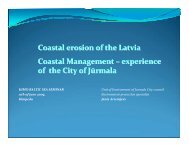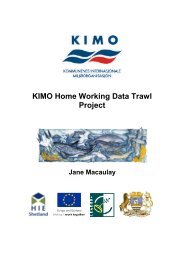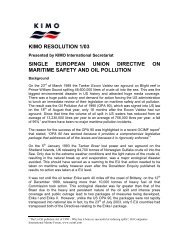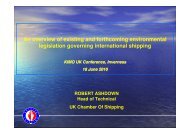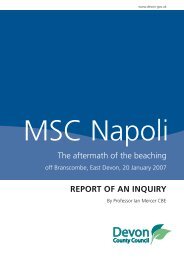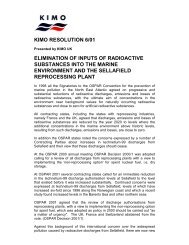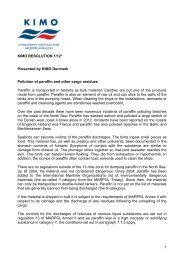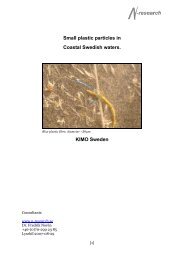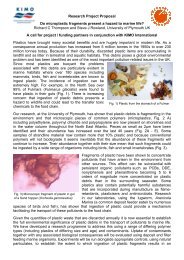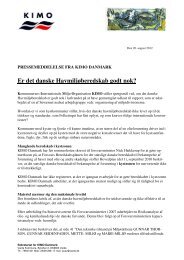good practice guide series oil pollution contingency plan guidelines ...
good practice guide series oil pollution contingency plan guidelines ...
good practice guide series oil pollution contingency plan guidelines ...
Create successful ePaper yourself
Turn your PDF publications into a flip-book with our unique Google optimized e-Paper software.
GOOD PRACTICE GUIDE SERIES<br />
Local Authorities International<br />
Environmental Organisation<br />
OIL POLLUTION<br />
CONTINGENCY PLAN<br />
GUIDELINES FOR COASTAL LOCAL<br />
AUTHORITIES<br />
CHECKLIST
Based on experiences as a result of major <strong>oil</strong> tanker<br />
disasters such as the MV Braer (Shetland 1993) and<br />
the MV Sea Empress (Pembrokeshire 1996)<br />
A Manual has been produced to accompany this<br />
Checklist and is available from KIMO upon request
contents<br />
Introduction 1<br />
Guidelines Checklist<br />
Section 1 Dimensions of the Plan 5<br />
Section 2 Roles & Responsibilities of Lead 7<br />
Agencies<br />
Section 3 Notification Procedure 9<br />
Section 4 Oil Pollution Risk Assessment 11<br />
Section 5 Spill Response Strategies 12<br />
Section 6 Waste Disposal 13<br />
Section 7 Ability to Respond 14<br />
Section 8 Response Guide 15<br />
Section 9 Health & Safety 16<br />
Section 10 Command and Control 18<br />
Section 11 Shoreline Response Centre 19<br />
Section 12 Management Team 21<br />
Section 13 Technical Team 22<br />
Section 14 Environmental Team 23<br />
Section 15 Financial Team 24<br />
Section 16 Logistics Team 25<br />
Section 17 Press & Public Relations Team 28<br />
Section 18 Wildlife Response Team 30<br />
Section 19 Monitoring Team 32<br />
Section 20 Compensation & Cost-Recovery 33<br />
Section 21 Prosecution 35<br />
Section 22 Effects on the Local Economy 36<br />
Section 23 Conclusion 38
Introduction<br />
Background<br />
Vast quantities of <strong>oil</strong> are regularly transported around the<br />
world and although it is a well-established <strong>practice</strong>, the<br />
risk of a major <strong>oil</strong> spill occurring is considerable. The<br />
consequences of a spill are profound and can adversely<br />
affect beaches, wildlife, fisheries, human health, tourism<br />
and industrial <strong>plan</strong>t. Moreover, there may be a serious<br />
impact to the local economy of the coastal area<br />
Definition of ‘<strong>contingency</strong>’<br />
‘A <strong>contingency</strong> is an event which may happen, the timing<br />
of which is obscure or unknown.’<br />
The purpose of this <strong>guide</strong><br />
This <strong>guide</strong> is offered as assistance to Local Authorities, as<br />
a checklist, in the preparation of their Oil Pollution<br />
Contingency Plans. However, it is simply intended to outline<br />
a set of <strong>guide</strong>lines, a starting point, which are not exhaustive<br />
in detail and is meant to be used in tandem with an<br />
accompanying manual which has also been produced. It<br />
is based on the experiences of the grounding of the <strong>oil</strong><br />
tankers MV Braer in Shetland and MV Sea Empress in<br />
Pembrokeshire.<br />
The application of the checklist<br />
It is generally accepted that Local Authorities are one of<br />
the frontline agencies for dealing with emergencies, including<br />
coastal <strong>pollution</strong>. It is; therefore, appropriate that local<br />
coastal authorities develop a Contingency Plan to deal with<br />
unforeseen <strong>pollution</strong> incidents. It is recognised that many<br />
countries have different procedures and agreements and<br />
this <strong>guide</strong> may not always be indicative of local<br />
circumstances.<br />
The information contained in this document, to the<br />
best of our knowledge was correct at the time of<br />
publication. This <strong>guide</strong> is meant only as an “aidememoire"<br />
and KIMO assumes no responsibility for any<br />
1
omission or for any actions that might arise as a result<br />
of using this <strong>guide</strong>.<br />
The International Convention on Oil Pollution<br />
Preparedness, Response, and Co-operation, 1990<br />
Many countries expressed their desire for the development<br />
of an international co-operative framework for combating<br />
major <strong>oil</strong> <strong>pollution</strong> incidents. The Marine Environment<br />
Protection Committee (MEPC) of the International Maritime<br />
Organisation (IMO) was given this responsibility and, on<br />
13 May 1995, the Oil Pollution Preparedness, Response,<br />
and Co-operation Convention (OPRC) came into force<br />
internationally. The Convention places various obligations<br />
on signatories, including, under Article 3, the preparation<br />
of Oil Pollution Emergency Plans.
What are the aims of an Oil Pollution Contingency<br />
Plan<br />
· To provide direction and guidance to those involved in<br />
responding to an <strong>oil</strong> spill incident; and,<br />
· To identify the most appropriate and successful response<br />
to minimise the damage, whether that be environmental,<br />
ecological, recreational or financial, that would be caused<br />
by an <strong>oil</strong> spill.<br />
What are the objectives of an Oil Pollution Contingency<br />
Plan<br />
· To identify the geographical area covered<br />
· To identify the responsible authority and boundary of the<br />
<strong>plan</strong>’s operation<br />
· To articulate agreed command and control arrangements<br />
· To define roles and responsibilities<br />
· To identify early warning and notification procedures<br />
· To articulate a communications <strong>plan</strong> to articulate a<br />
contact cascade and directory<br />
· To consult with all relevant agencies<br />
· To carry out an adequate <strong>oil</strong> spill risk assessment<br />
· To identify pre-agreed response strategies<br />
· To articulate a disposal <strong>plan</strong><br />
· To identify response capability<br />
· To define mobilisation procedures<br />
· To address health and safety aspects<br />
· To identify and implement a financial control system in<br />
advance<br />
· To interact successfully with other relevant <strong>plan</strong>s<br />
· To carry out post operation review and implement an<br />
amendment policy<br />
· To articulate procedures for dealing with the media,<br />
including a public relations <strong>plan</strong><br />
· To develop post-spill marketing programmes<br />
3
Section 1<br />
Dimensions of the Plan<br />
Is the scope of the <strong>plan</strong> defined<br />
· Geographic area<br />
· Concerned with <strong>oil</strong> spills<br />
· To the marine environment and the shoreline<br />
· May require a local, national or international response<br />
· May extend to hazardous substances<br />
Is the content of the <strong>plan</strong> defined<br />
Strategy<br />
· Policy<br />
· Scope<br />
· Division of responsibilities<br />
· Perceived risks<br />
· Proposed response strategies<br />
· Logistical support<br />
· Post-operation activities<br />
Operational Plan<br />
· Emergency response procedures<br />
Data Directory<br />
· Contact details<br />
· Resource listings<br />
· Relevant maps<br />
· Safety assessments<br />
· Pre-agreed response strategies<br />
Map<br />
· Area of the <strong>plan</strong>’s operation<br />
Is there a procedure for developing a <strong>plan</strong>/gathering<br />
information<br />
5
Is there a <strong>plan</strong>ned management and design process<br />
· List of copy holders and locations<br />
· Revision record<br />
· Summary of relevant legislation<br />
· Glossary of terms and abbreviations<br />
· Good index<br />
· Section dividers<br />
· Stored on computer hard drive<br />
· Hard copy – a4, ringbinder<br />
Is there an amendment policy<br />
· Annual review of the <strong>plan</strong> and procedures<br />
· Post incident review<br />
Has the <strong>plan</strong> been tested with an emergency exercise<br />
Are there training/safety schedules
Section 2<br />
Roles & Responsibilities<br />
of Lead Agencies<br />
Is the role of the local authority defined<br />
Lead agency in shoreline clean-up<br />
Decision maker as to whether to set up a shoreline response<br />
centre<br />
Arrange logistical aspects<br />
Refers to and integrates related <strong>contingency</strong> <strong>plan</strong>s<br />
Consults with all agencies with a duty or interest in the<br />
response<br />
Keeps an up-to-date contact list of those agencies<br />
Is the role of the Maritime Pollution Control Agency<br />
or equivalent defined<br />
Early notification<br />
Preliminary estimation of an emergency<br />
Lead agency in action at sea<br />
Search and rescue<br />
National stockpile of <strong>oil</strong> spill clean-up equipment/resources<br />
Technical advice<br />
Assistance with shoreline clean-up<br />
Grants standing approval for dispersant use<br />
· if approval has been granted, is a copy included in<br />
the <strong>plan</strong><br />
· if approval has not been granted, does the <strong>plan</strong><br />
indicate when it must be sought<br />
Is the role of the <strong>oil</strong> industry/sector defined<br />
Expertise/resources in an <strong>oil</strong> spill response<br />
Is the role of the nature conservation/wildlife<br />
agencies defined<br />
Advice/expertise on the location of sensitive sites<br />
Is the role of the Environment Protection Agencies<br />
defined<br />
Booming resources/expertise/enforcement<br />
7
Is the role of the port and harbour authorities defined<br />
Is the role of the International Tanker Owners<br />
Pollution Federation Ltd (ITOPF) defined<br />
Responds to <strong>oil</strong> spills<br />
Assists in damage assessment and analysis of claims<br />
Contingency <strong>plan</strong>ning<br />
Training and education<br />
Is the role of the International Oil Compensation<br />
Fund Ltd (IOPC fund) defined<br />
Representatives of the compensation regime<br />
Is the role of the protection & indemnity clubs defined<br />
Insurers of tanker owners<br />
Is the role of the emergency services defined<br />
Maintain a safe environment/security<br />
Liaison officers<br />
Are the roles of other agencies with an interest defined<br />
· Weather station<br />
· Telecommunications provider<br />
· Local radio/television/media<br />
· Transport providers – hauliers/ferry<br />
companies/airlines/airport authorities/rail network<br />
· Fisheries & agricultural organisations (NGO’s)<br />
· Tourist board<br />
· Contractors<br />
· Landowners<br />
· Health & safety authority<br />
· Politicians (MP’s, MEP’s, VIP’s etc)<br />
· European Commission
Section 3<br />
Notification Procedure<br />
Is the alert procedure defined<br />
Is the person responsible for notification identified<br />
Is there a list of contacts included in the <strong>plan</strong><br />
Are the contact details updated/reviewed periodically<br />
Is the procedure for notifying the following key agencies<br />
defined<br />
Tier 1<br />
· Maritime Pollution Control Agency (MPCA) or equivalent<br />
· Local Authority<br />
· Department of the Environment<br />
· Fisheries & Agricultural departments<br />
· Nature conservation/wildlife agencies<br />
· Marine laboratory<br />
· Fisheries & Agricultural organisations (NGO’s)<br />
· Environment agencies<br />
· Port and Harbour authorities<br />
· Oil industry<br />
· Health & Safety authorities<br />
Tier 2 as tier 1 plus:<br />
· Local fisheries and wildlife experts<br />
Tier 3 as tier 2 plus:<br />
· Emergency services<br />
9
Other interested agencies:<br />
· Local health boards<br />
· International Tankers Owners Pollution Federation Ltd<br />
(ITOPF)<br />
· International Oil Pollution Compensation fund (IOPC<br />
fund)<br />
· Protection & Indemnity Club (P & I club)<br />
· Weather station<br />
· Telecommunications provider<br />
· Local radio/television/media<br />
· Transport providers – hauliers/ferry companies/<br />
airlines/airport authorities/rail network<br />
· Politicians<br />
· European commission<br />
· Tourist board<br />
· Contractors<br />
· Landowners
Section 4<br />
Oil Pollution Risk Assessment<br />
Has an <strong>oil</strong> <strong>pollution</strong> risk assessment been carried out<br />
Have all relevant factors been taken into account<br />
· Potential sources of <strong>pollution</strong><br />
· Types of <strong>oil</strong> handled<br />
· Likelihood of an <strong>oil</strong> spill<br />
· Potential size of an <strong>oil</strong> spill<br />
· Quantities handled<br />
· Frequency of handling<br />
· Shipping vessels/type<br />
· Volume of traffic<br />
· Navigational hazards<br />
· Geographic location<br />
· Time of the year/seasons<br />
· Time of the day – daytime/night time<br />
· Weather – wind/climates<br />
· Sea conditions – tides/currents<br />
· Physical features of the coastline<br />
· Regenerative ability of the area<br />
· Effects of an <strong>oil</strong> spill to the area<br />
· Sensitivity of the area<br />
· Environmental<br />
· Recreational<br />
· Commercial<br />
· Medical<br />
· Accessibility to areas of the coastline<br />
· Ability to respond/available resources<br />
Are priorities for protection identified and agreed<br />
· Appropriate balance between environmental, amenity<br />
and economic values<br />
11
Section 5<br />
Spill Response Strategies<br />
Are the philosophies and objectives of the response<br />
defined<br />
Is the range of clean-up methods known<br />
Have limiting factors and adverse conditions been<br />
taken into account<br />
· Limitations of the various clean-up methods<br />
· Legal considerations for example, regulations may exist<br />
in relation to the use of dispersants<br />
· Weather<br />
· Logistical constraints<br />
· Available resources<br />
Is the strategy for priority areas defined<br />
· Booms<br />
· Disperse the <strong>oil</strong> with chemicals<br />
· Leave alone<br />
Is the strategy for the shoreline defined<br />
· Allow to collect<br />
· Remove floating <strong>oil</strong><br />
· Clean up stranded <strong>oil</strong> and <strong>oil</strong>ed beach materials<br />
Is the strategy at sea defined<br />
· Monitor and evaluate<br />
· Disperse the <strong>oil</strong> with chemicals<br />
· Protection, containment and recovery<br />
· Burning
Section 6<br />
Waste Disposal<br />
Where can wastes legally be held or disposed of<br />
· Familiarisation with legal requirements and procedures<br />
· Possession of any necessary paperwork<br />
· Prior notification consultation with the regulators and<br />
landowner<br />
· Existence of a licensed site<br />
· Existence of a clearance period<br />
· Requirement to pay a fee<br />
· Consultation with carriers/landowners<br />
· Consequences of a breach of the requirements<br />
What is the best environmental option for each type<br />
of waste<br />
· Recover the <strong>oil</strong><br />
· Biodegradation<br />
· Direct disposal<br />
Have storage sites been identified<br />
· Temporary<br />
· Intermediate<br />
· Final<br />
13
Section 7<br />
Ability to Respond<br />
Has there been an assessment of the ability<br />
and logistical resources required to respond<br />
to:<br />
Tier 1 – small operational spills<br />
Tier 2 – medium sized spills<br />
Tier 3 – large spills<br />
Have the following factors been considered<br />
· Availability of trained response personnel<br />
· Location of trained response personnel<br />
· Availability of response equipment<br />
· Location of response equipment<br />
· Mobilisation time<br />
· Transportation - airports/ports/harbours and rail and<br />
road network<br />
· Communications<br />
· Access to clean-up sites
Section 8<br />
Response Guide<br />
Is there written documentation of important<br />
facts/details<br />
· Specifications of <strong>oil</strong> commonly traded<br />
· Current, tides and weather conditions<br />
Is a sensitivity map included<br />
Does it include the following aspects:<br />
· Environmental sensitivities<br />
· Commercial sensitivities<br />
· Recreational and amenity areas<br />
· Hydrographic details<br />
· Priorities for protection<br />
· Methods of protection<br />
· Pre-agreed response strategies<br />
· Pre-agreed waste disposal sites<br />
· Details of access to sites<br />
· Load bearing characteristics<br />
· Logistical resources<br />
· Coastal facilities<br />
Is it easily understood<br />
15
Section 9<br />
Health & Safety<br />
Is there a safe working environment<br />
· Written health and safety programme<br />
· Health and safety risk assessment<br />
· Health and safety training<br />
· First aid stations/medical surveillance<br />
· Supervision from trained personnel<br />
· Working in teams<br />
· Communications network<br />
· Comprehensive reporting procedure<br />
· Comprehensive logging in/out procedure<br />
· Equipment cleaning stations<br />
· Protective clothing<br />
· Clothing stockpiles<br />
· Regular meals and refreshments<br />
· Cleaning and t<strong>oil</strong>et facilities<br />
· Accommodation<br />
· Shift working<br />
· Temporary exclusion zones<br />
· Counselling services<br />
Are potential hazards identified<br />
· Distribution of health and safety assessment sheets<br />
· The spilt <strong>oil</strong><br />
· Clean-up equipment<br />
· Clean-up chemicals<br />
· Improper decontamination<br />
· Weather<br />
· Nature of the shoreline<br />
· Sea state<br />
· Chemical stockpile/condition
Are decontamination procedures defined<br />
· Identification of equipment to be kept<br />
· Identification of equipment to be discarded<br />
· Methods to be used to decontaminate equipment<br />
· Procedures for packaging, labelling and discard of<br />
contaminated materials<br />
· Contamination reduction area<br />
· Clean-up area<br />
· Waste disposal <strong>plan</strong><br />
Has the public liability aspect been considered<br />
· Insurance<br />
· Duty of care<br />
· Working time<br />
17
Section 10<br />
Command and Control<br />
Shoreline Response Centre (SRC) organisation<br />
· Identified who is in charge<br />
· Is there an effective incident management system<br />
· What agencies are involved<br />
· Is there an incident organisation chart<br />
· Is there co-operation and co-ordination between all<br />
agencies<br />
· Are there clear lines of communication<br />
· Has the location/administrative infrastructure, etc<br />
been identified<br />
Are team structures and chairs identified<br />
· Management team<br />
· Technical team<br />
· Environmental team<br />
· Financial team<br />
· Logistics team<br />
· Press and public relations team<br />
· Wildlife response team<br />
· Monitoring team<br />
Have action sheets been developed and define:<br />
· Staff roles<br />
· Staff responsibilities/actions<br />
· Staff accountability<br />
Is procedures for mobilising a full response team<br />
defined<br />
Is there a contact directory<br />
· Details of all key personnel<br />
· Contact hierarchy<br />
· Preferred method of communication<br />
· Details are periodically updated
Section 11<br />
Shoreline Response Centre<br />
Has a site for the Shoreline Response Centre (SRC)<br />
been located<br />
· Ideally close to the incident site<br />
· Access<br />
· Good transport links<br />
· Car parking<br />
· Security<br />
Are there adequate facilities<br />
· Space<br />
· Rest and refreshment areas<br />
· Storage space<br />
· Wash and t<strong>oil</strong>et facilities<br />
· Electrical and telephone points<br />
Is there an effective communications network<br />
· Advanced negotiations/consultation with<br />
telecommunications provider<br />
· Initial notification procedures<br />
· Subsequent mobilisation procedures<br />
· Ongoing operations procedures<br />
· Telephone, telex, fax, satellite, VHF radio, mobile<br />
phone, e-mail<br />
· Diagrammatic representation<br />
Are there links to and between:<br />
· Internal lines<br />
· Main switchboard<br />
· External lines<br />
· Beach operations<br />
Is a floor <strong>plan</strong> included in the <strong>plan</strong><br />
19
Is necessary equipment provided/available<br />
· Reports, manuals, maps, charts, incident logs, status<br />
boards, etc<br />
· Computers, printers, photocopiers, faxes, etc<br />
· Locations noted<br />
· Stock control - regular checks, maintenance and<br />
replacement<br />
· Consideration of cost implications<br />
· Security<br />
· procedures for mobilisation
Section 12<br />
Management Team<br />
Does the team have the capability to:<br />
· Execute the <strong>plan</strong><br />
· Determine and agree strategic clean-up <strong>plan</strong>s for<br />
priority areas and the various polluted sites<br />
· Review operations<br />
· Gather and collate information<br />
· Authorise media releases<br />
· Control general financial aspects<br />
· Interact with other agencies/central<br />
government/press/public<br />
· Prepare formal detailed management and situation<br />
reports<br />
· Decide when to terminate operations<br />
21
Section 13<br />
Technical Team<br />
Does the team have the capability to:<br />
· Collect and evaluate incident information<br />
· Identify areas most at risk<br />
· Determine the best response strategy at each<br />
of the polluted sites<br />
· Allocate resources on a priority basis<br />
· Allocate outside contractors to specific sites<br />
and tasks<br />
· Implement the chosen strategy<br />
· Direct clean-up operations<br />
· Monitor the progress of the operation<br />
· Prepare daily incident logs
Section 14<br />
Environmental Team<br />
Does the team have the capability to:<br />
Provide advice on<br />
· The risk and vulnerability of environmental features<br />
to <strong>oil</strong> <strong>pollution</strong><br />
· Local sensitivities and location of wildlife habitats<br />
· Possible/probable impacts of the <strong>oil</strong><br />
· Priority for protection of sensitive sites<br />
· Environmental effect of clean-up methods<br />
· Potential and real effects on human health<br />
Thereafter:<br />
· Help implement the chosen strategies<br />
· Monitor and ensure environmental concerns are<br />
adequately reflected<br />
· Direct the wildlife response<br />
· Provide liaison links with environmental<br />
organisations<br />
· Prepare daily incident logs<br />
23
Section 15<br />
Financial Team<br />
Does the team have the capability to:<br />
· Establish a detailed financial accounting system in<br />
advance<br />
· Prepare procedures for preparing and submitting<br />
compensation claims in advance<br />
· Outline an approved emergency budget/memo of<br />
understanding<br />
· Allocate and promulgate cost codes<br />
· Notify all teams of the accounting procedure<br />
· Supervise the financial arrangements of the incident<br />
· Keep track of the entire incident related costs<br />
· Prepare financial reports<br />
· Take control of cost-recovery actions
Section 16<br />
Logistics Team<br />
Does this team have the capability to:<br />
Take into account the short/long term needs of the<br />
incident<br />
Identify available manpower<br />
Local authority departments<br />
· Draw teams from various different departments<br />
· Ensure there is back-up/cover<br />
Contract labour force<br />
· Contact details annexed<br />
Volunteers<br />
· Policy for utilising external help<br />
· Define a time when it is safe to use volunteers<br />
· Procedures for recording contact name, number,<br />
expertise<br />
· Develop a training programme<br />
Arrange suitable accommodation for<br />
contractors/external help<br />
· Bed & breakfast<br />
· Hotel<br />
· Youth hostels<br />
· Flotel<br />
· Passenger ship<br />
Arrange suitable transport<br />
· Car hire<br />
· Buses<br />
· Rough terrain vehicles<br />
· Aircraft<br />
25
Arrange catering:<br />
· Food preparation centre<br />
· Delivery vehicles<br />
· Communications between the centre/vehicles/feeding<br />
points<br />
Oversee health & safety aspects<br />
Arrange social activities/entertainment for external<br />
personnel<br />
Arrange/allocate administrative support for each<br />
functional team<br />
Take control of accounting and record keeping<br />
· Log and record all events<br />
· Develop suitable accounting records<br />
· Define procedures for passing records onto financial<br />
team<br />
Identify sources of <strong>oil</strong> spill equipment–<br />
primary/auxiliary/support<br />
· Oil companies<br />
· Contractors<br />
· Harbour authorities<br />
· Government agencies<br />
· Local operators<br />
· Local emergency services<br />
· Manufacturers
Define mobilisation procedures in relation to:<br />
· Availability<br />
· Manufacturer<br />
· Type<br />
· Size<br />
· Location<br />
· Transport<br />
· Contact<br />
· Delivery time<br />
· Cost contractual terms and conditions<br />
Arrange secure storage of equipment<br />
Define procedures for equipment inspection,<br />
maintenance, testing and replacement<br />
Define procedures for equipment and personnel<br />
cleaning<br />
Arrange <strong>oil</strong> and waste disposal<br />
27
Section 17<br />
Press & Public Relations Team<br />
Does this team have the capability to:<br />
Evaluate the extent of media interest<br />
Assess the impact of the media on the implementation<br />
of the Contingency Plan<br />
· Effect on the availability of local resources<br />
· Possible disruption to ongoing operations<br />
· Security aspects<br />
Develop media <strong>plan</strong>s for:<br />
· Local and international press<br />
· Pressure groups<br />
· Local community/politicians<br />
· Claimants<br />
· Central government and other authorities<br />
· Staff<br />
Locate an appropriate media centre<br />
· Near shoreline response centre<br />
· Adequate size<br />
· Canteen<br />
· T<strong>oil</strong>ets<br />
· Refreshments<br />
· Electricity/phone points<br />
Acquire necessary equipment<br />
· Phones, faxes, pcs (e-mail facilities), printers,<br />
tv/satellite, etc<br />
Arrange and prepare press briefings and conferences<br />
· Prepared in advance<br />
· Cleared by the management team<br />
· At set times<br />
· Attended by all representatives of agencies involved<br />
· Dissemination of factual and coherent information<br />
· Daily
Develop <strong>good</strong> working relationships<br />
Provide media kits<br />
Organise site visits<br />
Arrange travel for the press to/from site<br />
Record location of journalists<br />
Monitor attendance<br />
Record contact details<br />
Issue press passes<br />
Initial press release<br />
Less formal briefings – press/public/governmental officials<br />
Public consultation meetings<br />
Monitoring of media output<br />
Governmental/vip visits<br />
Security and control over the media<br />
Accommodating the media is a non-recoverable cost<br />
29
Section 18<br />
Wildlife Response Team<br />
Is there a separate wildlife <strong>contingency</strong> <strong>plan</strong><br />
(a <strong>good</strong> example of a wildlife <strong>contingency</strong> <strong>plan</strong> is the wildlife<br />
response co-ordinating committee <strong>contingency</strong> <strong>plan</strong> which<br />
was used in the MV Braer incident. for details on how to<br />
obtain a copy, contact the Shetland Islands Council)<br />
Is it fully integrated with the Local Authority <strong>plan</strong><br />
Is the structure of command and control clearly<br />
identified<br />
Does the team have the capability to:<br />
· Collect and record wildlife casualties<br />
· Rehabilitate wildlife casualties for release<br />
· Deal with wildlife fatalities<br />
· Provide advice to the various shoreline response<br />
centre teams<br />
· Prepare daily incident logs<br />
Has a site for a Wildlife Response Centre (WRC) been<br />
located<br />
· Close to the incident<br />
· Adequate space<br />
· Storage facilities<br />
· Wash and t<strong>oil</strong>et facilities<br />
· Refreshment areas<br />
· Electrical and telephone points<br />
· Sleeping areas<br />
· Car parking<br />
· Security<br />
Has a site for an emergency cleaning/rehabilitation<br />
centre been located<br />
· A local centre<br />
· Availability of mobile units<br />
· National centres<br />
· Advice sought from specialist/expert organisations<br />
· Periodic review of suitability and availability
Are there adequate facilities<br />
· Space<br />
· Heat<br />
· Ventilation<br />
· Freezer units<br />
· Drainage<br />
· Good water supply<br />
· Good transportation routes<br />
· Pool space<br />
· Communication facilities<br />
31
Section 19<br />
Monitoring Team<br />
Does this team have the capability to:<br />
Monitor and survey:<br />
· The movement of the <strong>oil</strong><br />
· The effects on the marine and coastal environment<br />
· The effects on wildlife<br />
· The effects of human health<br />
· The effects on the economy<br />
Provide guidance on:<br />
· Exclusion zones<br />
· What is to be learnt for the future<br />
Identify and agree priorities<br />
· Tracking the movement of the spill<br />
· Human health<br />
· Contaminated land and beach areas<br />
· Clean-up areas<br />
· Temporary waste disposal sites<br />
· Comparison/control areas<br />
· Marine environment<br />
· Atmosphere<br />
· Public, private and bottled water supplies<br />
· Water abstraction points<br />
· Areas close to the incident or shoreline<br />
· Areas in the prevailing wind<br />
· Livestock – living and slaughtered<br />
· Slaughterhouses<br />
· Effects on the valuable economic resources<br />
· Crops – growing and stored<br />
· Natural heritage<br />
Consider cost-recovery/compensation aspects<br />
· Costs of undertaking impact assessments are nonrecoverable
Section 20<br />
Is the compensation fund structure understood<br />
for further details, see the International Oil Pollution<br />
compensation fund manuals 1971 & 1992<br />
Do the financial arrangements in place address the<br />
following:<br />
The Legal Framework:<br />
1969 International Convention on Civil Liability<br />
for Oil Pollution Damage<br />
· Strict liability of tanker owners<br />
1971 International Convention on the Establishment of<br />
an International Fund for Compensation for Oil Pollution<br />
Damage<br />
· Establishment of the 1971 compensation fund<br />
The Role of International Tanker Owners Pollution<br />
Fund (ITOPF)<br />
· Damage assessment and analysis of claims<br />
The Role of the International Oil Pollution<br />
Compensation Fund (IOPC fund)<br />
· Representatives of the compensation regime<br />
The Role of Protection & Indemnity Club (P&I clubs)<br />
· Insurers of tanker owners<br />
Who the potential claimants are<br />
Compensation and<br />
Cost-Recovery Procedures<br />
· Anyone who has suffered ‘<strong>pollution</strong> damage’<br />
33
What ‘<strong>pollution</strong> damage’ is<br />
· Property damage<br />
· Economic loss<br />
· Environmental damage<br />
How claims are assessed<br />
· By a technical test of ‘reasonableness’<br />
Costs which are or may not be recoverable<br />
· Media/public relations activities<br />
· Impact assessments<br />
· Building emergency wildlife cleaning centres<br />
· Worker overtime<br />
· Internal contract workforce<br />
· Legal advice<br />
· Market recovery programmes<br />
The amount of compensation available under the<br />
two-tier system<br />
· Limited liability of tanker owners<br />
· Supplementary compensation from the fund<br />
· First come first served basis<br />
· Dividend where claims exceed available amount<br />
The time-limits for submitting a claim<br />
· Within 3 years from the date on which loss or damage<br />
occurred<br />
· Within 6 years from the date of the incident<br />
The procedures for submitting a claim<br />
· Presented to the insurers, the fund, or the local claims<br />
office<br />
· Made in writing<br />
· Supporting documentation<br />
· Particulars of the claimant, incident, loss, amount sought
Existing presumptions<br />
· Local authorities/central government may be the last in<br />
line to-recover costs<br />
Section 21<br />
Prosecution<br />
Is prosecution possible under<br />
local/national/international legislation<br />
Are the regulators/enforcers of the law identified<br />
Are they familiar with existing relevant legislation<br />
Are they familiar with the following particular aspects:<br />
· Appropriate court<br />
· Procedures for initiating court action<br />
· Time limits<br />
· Quantity and quality of evidence required<br />
· Financial consequences<br />
35
Section 22<br />
Effects on the Economy<br />
Are potential impacts on the local economy identified<br />
Market damage<br />
· Adverse/critical media attention<br />
· Reputation of the area/products may be destroyed<br />
· May affect the sale of all produce outwith the<br />
exclusion zone<br />
· Price damage – excuse for lower price and discounts<br />
Are Potential Impacts on the Fisheries & Agricultural<br />
industries identified<br />
Direct contamination<br />
· Exclusion zones for produce may be established<br />
· Intensive programme of sampling to be undertaken<br />
· Destruction of produce<br />
Long term biological damage to fisheries<br />
· Mainly in relation to shellfish<br />
· Stock levels<br />
· Spawning grounds<br />
Long-term biological damage to agriculture<br />
· Regenerative ability of the land<br />
· Crop yields<br />
Are potential impacts on the tourism industry identified<br />
· Tourist numbers<br />
· Income to the area<br />
· Local employment
What are the essential elements for the <strong>contingency</strong><br />
<strong>plan</strong><br />
General<br />
· Post-incident marketing programmes<br />
· Public relations<br />
Fisheries & Agriculture<br />
· Emphasise that contamination is limited to produce<br />
within the exclusion zone<br />
· Initiate sampling programmes of produce outwith the<br />
zone<br />
· Expand normal quality control procedures<br />
· Special events for the media<br />
· High profile visits from famous chefs/restaurants<br />
· Special visits for produce buyers/supermarket chains/<br />
food retailers<br />
Tourism<br />
· Raise extra funding to supplement existing tourism<br />
budget<br />
· Multi-media advertising campaign<br />
· New advertising and promotional material<br />
· Project a positive message<br />
· Schedule exhibitions<br />
· High profile press information and press visit programmes<br />
· Communicate with and inform potential visitors<br />
Have cost-recovery/compensation aspects been<br />
considered<br />
· Require the co-operation of the whole commercial industry<br />
· Submit claims separate from those of the local authority<br />
· Costs of marketing programmes may be non-recoverable<br />
37
Section 23<br />
Conclusion<br />
Are the aims of the Contingency Plan met<br />
· Direction and guidance is provided<br />
· The most appropriate and successful response is<br />
identified<br />
Are the objectives of the Contingency Plan met<br />
· The geographical area covered has been identified<br />
· The responsible authority and boundary of the <strong>plan</strong>’s<br />
operation has been identified<br />
· Agreed command and control arrangements have been<br />
articulated<br />
· Roles and responsibilities have been defined<br />
· Early warning and notification procedures have been<br />
identified<br />
· A communications <strong>plan</strong> has been articulated<br />
· A contact cascade and directory has been articulated<br />
· Consultation with all relevant agencies has been<br />
carried out<br />
· An adequate <strong>oil</strong> spill risk assessment has been<br />
carried out<br />
· Pre-agreed response strategies have been identified<br />
· A disposal <strong>plan</strong> has been articulated<br />
· Response capability has been identified<br />
· Mobilisation procedures have been defined<br />
· Health and safety aspects have been addressed<br />
· A financial control system has been identified and<br />
implemented in advance<br />
· It interacts successfully with other relevant <strong>plan</strong>s<br />
· A post-operation review has been carried out and an<br />
amendment policy has been implemented<br />
· Procedures for dealing with the media, including a<br />
public relations <strong>plan</strong>, have been articulated<br />
· Post-spill marketing programmes have been<br />
developed
An International Partnership<br />
Working Together<br />
to Improve<br />
Northern Seas Environments<br />
This Checklist and the accompanying Manual are<br />
available on the KIMO Website at<br />
http://www.zetnet.co.uk/coms/kimo<br />
Acknowledgements<br />
Special thanks for the support of Shetland Islands<br />
Council and Pembrokeshire County Council and the<br />
other agencies which assisted in the production of<br />
this <strong>guide</strong>.<br />
This Guide and the accompanying Manual were<br />
produced under the Shell STEP Programme (Shell<br />
Technology and Enterprise Programme) by Miss Marie<br />
Peterson.<br />
Supported by<br />
Shell U.K. Exploration and Production<br />
“KIMO’s primary objective is the cleaning up of the<br />
existing <strong>pollution</strong> in Northern Seas and coastal waters,<br />
of preventing future <strong>pollution</strong> and working to preserve<br />
and enhance them and to leave them in a fit and healthy<br />
state for the well-being of future generations”



